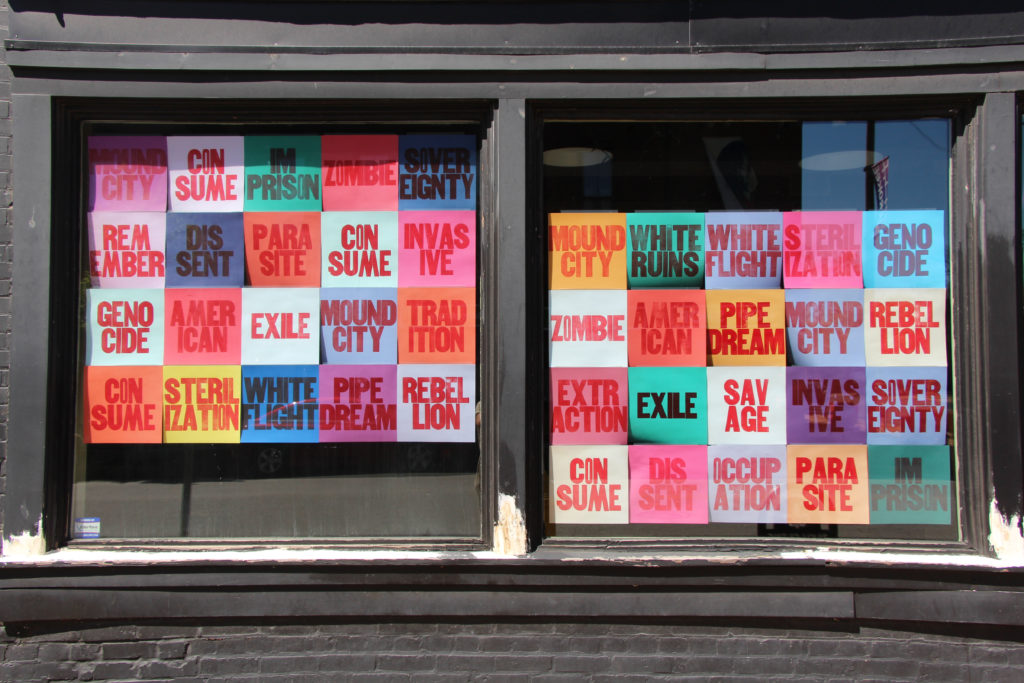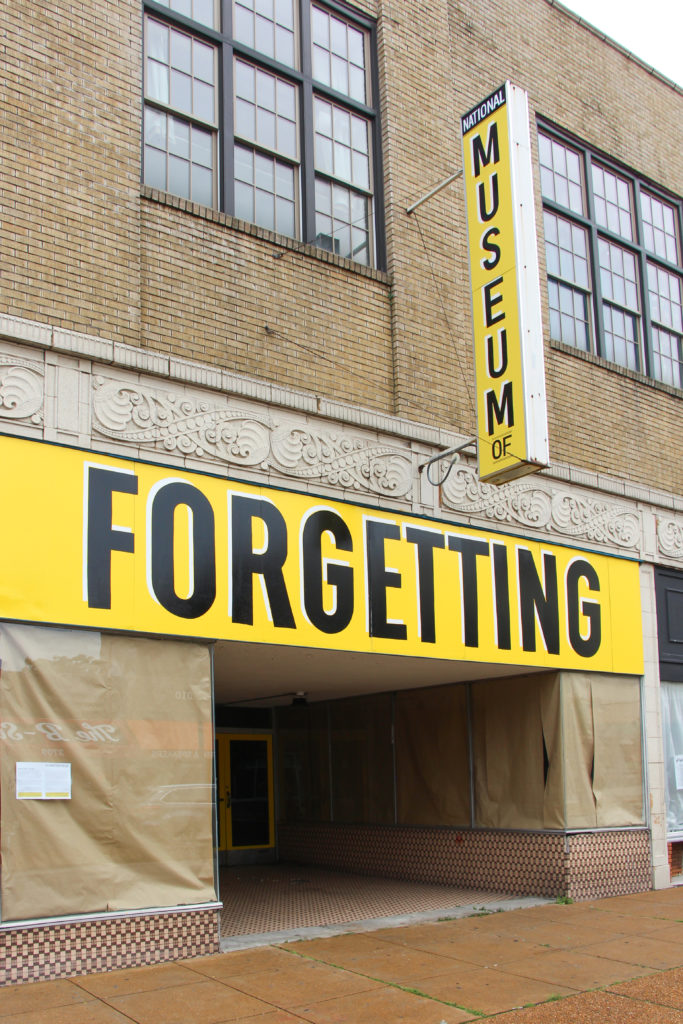Tending a Public: Counterpublic Triennial // St. Louis
by Joel Kuennen

The Luminary, an anchor arts organization in St. Louis helmed by founders Brea Youngblood and James McAnally and curator Katherine Simóne Reynolds, undertook its first triennial this year. The triennial, Counterpublic, took form as a series of installations and provocations within local businesses in a predominantly Mexican business district known as Cherokee Street.
On the first day of my visit to Counterpublic, in an already sweltering Missouri summer, I sought refuge from the heat in a charro store called Carillo Western Wear, a concealed exhibition site. I thumbed through brocade, pearl button shirts, and gazed around at the stacks of cowboy hats that cascaded down from the ceiling in shades of tan. There was a pink one, with spikes, and then another and another, mixed in with the rest. I looked through more shirts and found one with odd, iron on patches with a script that read like a dare:
Do TWO of the following, choosing a different group for each:
a. Go to a festival, celebration, or other event identified with one of the groups. Report on what you see and learn.
b. Go to a place of worship, school, or other institution identified with one of the groups. Report on what you see and learn.
c. Talk with a person from one of the groups about the heritage and traditions of the group. Report on what you learn.
d. Learn a song, dance, poem, or story which is traditional to one group, and teach it to a group of your friends.
e. Go to a library or museum to see a program or exhibit featuring one group’s traditions. Report on what you see and learn.
I remembered this…why did I remember this? It seems so altruistic nowadays, these dares to go experience the diversity of our nation. Or maybe it seems sinister—post-9/11, it is hard not to read the command “Report on” in Orwellian terms. Then it dawned on me: they were steps to fulfilling the requirements for a Boy Scouts of America merit badge, specifically the American Cultures merit badge. Requirements for the Citizenship in the Nation and the World and American Heritage badges clung to other panels of the shirt meant for peacocking.
This was the work of Yowshien Kuo, and while the cheap, iron-on patches felt unconsidered, but albeit necessary—the majority of the artist stipend went to purchasing hats and shirts from the store—the gesture was perfectly executed. Here I was, in a charro store, a store I would likely not have gone into had it not been on the map of Counterpublic locations, having an hour-long conversation with the store owner’s son about the development and maintenance of charro culture, his experience as a first generation American, and this triennial that had inserted itself into the Cherokee Street neighborhood. Kuo’s work illustrated acculturation while avoiding appropriation, forming ties with cultures that exist as a way to create something new, something that can be called home.
‘Counterpublic,’ a term coined by Nancy Fraser in the 1990s, is used to describe groups developing counter-discourses within the public sphere to construct identities in opposition to the dominant paradigm. In the past, these groups have always existed voraciously, but were separated by distinct media spheres. Independent publishing arms like AK Press, for example, served as a hub for the anarcho-communist inclined, within a hardening neoliberal America. Those on the evangelical right would scarcely ever know or hear of this press. Counterpublics developed in relative isolation. However, all this changed when the media that shapes and holds the public sphere went online. Michael Warner points to the Internet’s ability to breakdown the broadcast model from three main networks that determined public discourse for decades, saying it has “fractured the language of the public.”1
That is where we are now, a fractured public. This is not necessarily a bad thing. Yes, we see a lot more of the repugnant counterpublics; white supremacy, neo-nazis, straightup racist dumbasses. But we also see Queerness, Blackness, Desiness, Latinxness, Indigiousness. We see a normalization of socially progressive values at a speed unheard of in the last century. The public sphere of today, it could be said, is one of many counterpublics entering an expanded sphere of public discourse and power.

This public of today is seen in Kimi Hanauer’s dedication posters that cover a building at the corner of Cherokee St and Jefferson Ave, which state, “TO THOSE FOR WHOM THE ENTIRE WORLD IS A FOREIGN LAND.” It is seen cater-corner to Demian DinéYazhi´’s placards that read“OCCUPATION, GENOCIDE, STERILIZATION,” covering the shop windows of the coffeeshop, Foam. Posters on the wall inside the shop implore patrons to “LISTEN TO INDIGENOUS VOICES,” while outside, a towering, stereotypical statue of a “Cherokee Indian” erected in the 1980s by the local chamber of commerce, in an attempt to gin up business on Cherokee Street,2 gazes eastward towards Cahokia—the site of the largest Native American city north of Mesoamerica. The city, which at its height in the thirteenth-century was larger than London, traded in Mill Creek chert, a valuable stone for making tools to farm the land. The concrete sidewalks of Cherokee Street are flecked with bits of the brownish-ochre chert, now used as aggregate filler.
Once counterpublics are acknowledged by the realm of the hegemonic public sphere, they can begin to grow. We see the negative aspects of this phenomena in the rise of Trumpian white supremacy and the transformation of long-dormant racist ideology into mainstream dogma for an entire party. Conversely, Counterpublic artists like Cauleen Smith and Isabel Lewis remind us that the new paradigm of an expanded public sphere allows for the development of new ways of being in community that can do away with discourses of hatred and exclusion.
In Treffpunkt, the former St. Mathew church turned lecture hall, Cauleen Smith’s installation Sky Will Learn Sky (2019) fills the nave of the church with sheer, orange banners bearing lyrics from Alice Coltrane: “AT DAWN / SIT AT THE FEET OF ACTION.” In the church basement, her film Sojourner (2018) plays on a stage, working through the radical imagining of alternative futures represented by the work of Simon Rodia (the artist behind Watts Towers); Noah Purifoy’s sculptural desert town; and founder of the first Black shaker community, Rebecca Cox Jackson. Smith’s film inserts young people of color into these sites of alterity, bridging the gap of history to show that the imaginaries of new futures are possible, are rooted in what has been and are, ultimately, possible.
My time in St. Louis ended with a performance of an alternative future—one built on love, on tending, on joy. Isabel Lewis hosted an “occasion” at Cherokee Street Yoga. The Berlin-based artist danced around the studio, into the space of each person present, vibrating the air of the yoga studio as the sunset’s golden light filled the room. In dance breaks she shared vials of scents, asking “What would rational thought smell like?” before passing around a bottle that smelled of burdock, citrus, and steel. After another round of reiki-like dance confrontations, a short discussion on Alcibiades’ desire to satiate his thirst for Socrates’ wisdom through erotic love. Then came the scent of Intellectuality—a swamp overgrown with periwinkle—followed by a short lecture on Martha Nussbaum and Profane Love. The third scent, created in collaboration with Sissel Tolaas, represented the space of integration and was based on the smell of Berghain, the notoriously hedonistic club in Berlin. It smelled of poppers, the body, citron, and polycarbons.
Lewis’ occasion ended with her turning to the audience to ask about gardening. What does it mean to tend? To allow for flourishing? Audience members shared their experiences living with plants, caring for them, and the eventual realization that the love we show plants, providing a conducive environment for growth without forcing control, is how we must tend to each other.
Counterpublic ran throughout the city of St. Louis from April 13 to July 13, 2019.